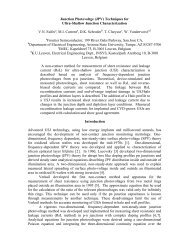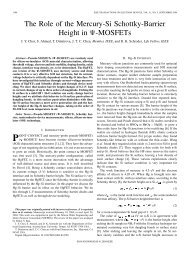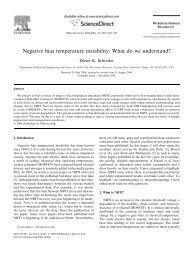ECS Transactions 3, (4), 321-337 (2006) - Dieter Schroder - Arizona ...
ECS Transactions 3, (4), 321-337 (2006) - Dieter Schroder - Arizona ...
ECS Transactions 3, (4), 321-337 (2006) - Dieter Schroder - Arizona ...
Create successful ePaper yourself
Turn your PDF publications into a flip-book with our unique Google optimized e-Paper software.
<strong>ECS</strong> <strong>Transactions</strong> 3, (4), <strong>321</strong>-<strong>337</strong> (<strong>2006</strong>)<br />
Strain in semiconductors leads to birefringence (change in refractive index) resulting<br />
in a phase shift of transmitted light, that is proportional to the strain in the sample. Polariscopy<br />
is a nondestructive, highly sensitive and quantitative mapping technique for residual<br />
strains in semiconductor wafers, based on the strain-induced birefringence. 30 The<br />
experimental arrangement for plane and circular polariscopes is schematically shown in<br />
Fig. 13. For transmission semiconductor stress measurements, light with hν < E G is used.<br />
The infrared light passes through the polarizer and becomes circularly polarized. As light<br />
propagates through the silicon, residual stress-induced birefringence changes it from being<br />
circularly to elliptically polarized. The resulting phase shifts affect the polarization<br />
state of transmitted light waves. The intensity of polarization transmission is 31<br />
2 2<br />
2<br />
I<br />
t<br />
= I<br />
i<br />
(1 − R)<br />
(cos χ − sin 2( φ −θ<br />
)sin 2( φ −θ<br />
+ χ)sin<br />
δ / 2) [10]<br />
where I i is the intensity of incident light, R the reflectivity, θ the principal angle which<br />
determines the orientation of the stress axis at the plane, χ the angle between polarizer<br />
and analyzer and φ the azimuth angle of the polarizer, shown in Fig. 13. The polarization<br />
intensity I t measured at selected orientations of the polarizer and analyzer, depends on the<br />
optical retardation parameter δ, which is directly related to the residual elastic strain.<br />
I i is generally polarization dependent. Hence a method that does not require I i and R<br />
is as follows. Two transmitted intensities of the polarized light are measured: one with<br />
polarizer and analyzer parallel to each other, I<br />
||<br />
(χ = 0), and the second when the polarizer<br />
is orthogonal to the analyzer, I<br />
⊥<br />
(χ = π/2). By measuring the angular φ-dependence of the<br />
current ratio one can determine quantitatively the optical retardation, δ, and the direction<br />
of the principal stress angle, θ, using the equation<br />
I<br />
⊥<br />
2<br />
2<br />
= sin ( φ −θ )sin ( δ / 2)<br />
[11]<br />
I<br />
⊥<br />
+ I||<br />
allowing stress to be determined. Example polariscopy images of stressed Si wafers are<br />
shown in Fig. 14.<br />
(a)<br />
(b)<br />
Figure 14. (a) Residual stress in EFG Si wafer. Courtesy of S. Ostapenko, Univ. of South<br />
Florida, (b) stress induced by small crack in Si wafer. Courtesy of J. Lesniak, Stress<br />
Photonics.<br />
Temperature<br />
Raman spectroscopy. High spatial resolution temperature can be measured with Raman<br />
spectroscopy, since temperature changes the optical phonon energy leading to a shift in<br />
the scattered phonon’s energy, shown in Fig. 15. For Si the shift is –0.021 cm -1 /K. Fig.<br />
16(a) shows the temperature along the width of a Si MOSFET clearly illustrating the<br />
non-uniform temperature distribution in the width direction. 32 Fig. 16(b) shows the local<br />
333








